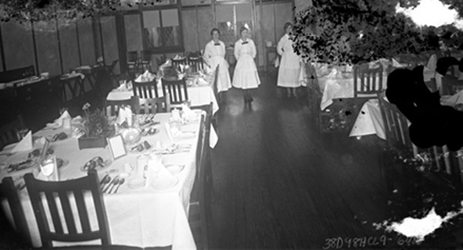The Harvey House

The Santa Fe Railroad announced its intention to construct a Harvey House next to the Santa Fe Depot in 1909: “Great is the Santa Fe,” the Canadian Record of October 7, 1909, stated, “and we are proud to be on its line.” The new Santa Fe buildings by the tracks were completely destroyed by fire in 1910, but the Santa Fe was undaunted by this setback, and after replacing them, continued construction of the Harvey House.
The Harvey House cost the railroad $36,000, and its presence meant trains would stop for the first time for meals in Canadian. The Record told it readers: “...more traffic will be sent this way. In the near future a California train will pass through Canadian, but not without stopping.”
The Harvey House was a two-story brick structure by the track, connected to the depot with covered walkways. It did not have any hotel accommodations, but had a dining room and a lunch room, with employee bedrooms on the second floor. “The most substantially built structure in the town,” the Harvey House was part of a planned system of Harvey Houses that promised to bring additional passenger traffic through this division of the Santa Fe. Canadians recognized the Santa Fe’s influence in shaping their community.
Canadians old enough to remember say that most Harvey Girls at the house were local women. A few were sent in, especially to get the house opened and on its feet. The manager, chef, and baker were never from the area, but many local women found work there over the years at the Canadian Harvey dining room and lunch counter.
At the age of 15, Fred Harvey left his native England for the United States. Upon his arrival in New York City, Mr. Harvey began working in the restaurant business. The Civil war was bad for restaurants but good for the railroad, and Mr. Harvey made a career change. Over the next 20 years, Mr. Harvey moved ever westward and even higher in railroad business, but never forgot his restaurant beginnings. Traveling for the railroads over the time enforced Mr. Harvey’s view that improvement was needed in the food department.
Upon arrival in Kansas in 1870, Mr. Harvey met Charlie Moorse, President of the fledgling Atchison, Topeka, and Santa Fe Railway. For the next near century, Fred Harvey’s company would bring good food at reasonable prices in clean, elegant, restaurants, to the traveling public in the southwest. They also brought civilization, community, and industry to the Wild West. A short 15 years later, there were 17 Harvey Houses; at their peak, there were 84!
He began hiring women at a time when most jobs for women were as domestics or teachers. His own experience with the men that he had hired were as wild as the west was. He advertised in the East for women to work for him. Paying as much as $17.50 per month with free room, board, and clean uniforms. The company prospered with these new helpers. Each girl signed a 1 year contract not to marry. Advertisements for Harvey Girls read “young women of good character, attractive, intellegent, 18 - 30 years old.” They attended a special training corps where they were taught personal grooming and the art of serving food with elegance.
The Harvey House in Canadian, Texas opened in 1910, and closed in 1939. A few of the original Harvey girls are still residents in this wonderfully historic town, Rachel Kelly and Alice Garnas. Canadian owes a lot of its life to the railroad and to the Fred Harvey Company, without which this thriving community may not have become what it is today.
The following are some of the Harvey House employees that became Canadian residents:
Elizabeth Alice Garnas 1909, Yugoslavia Harvey Girl, NM, 1926-1929
Warren Harrington Busboy, Canadian, TX 1929-1932
Elizabeth Hazelwood 1897 Harvey Girl, Canadian, TX 1926-1939
Rachel Kelly Oklahoma Harvey Girl, Canadian, TX 1927
Una Gertrude Atchison Matthews Texas Harvey Girl, Canadian, TX 1925

